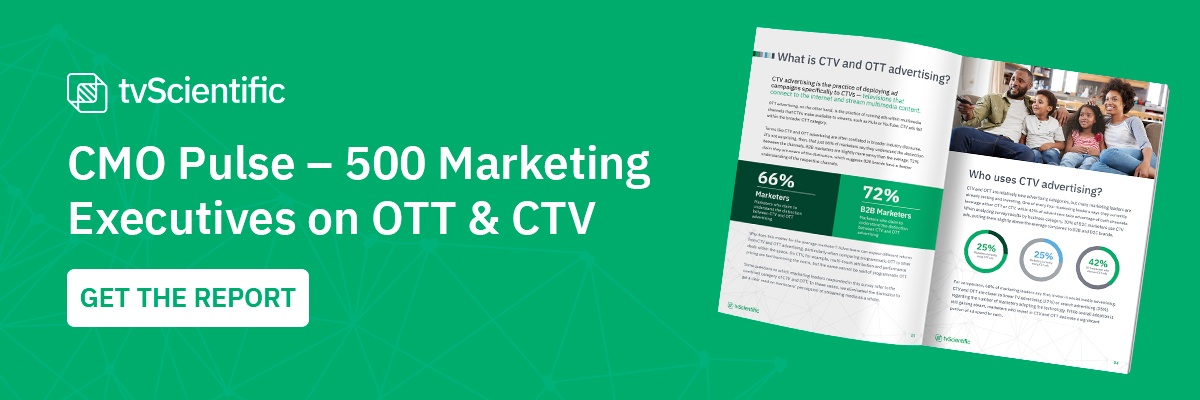Knowing the difference between OTT and VOD can make a world of difference.
Knowing the differences between OTT and VOD — and the opportunities they present — is crucial for performance marketers
Though television consumption increased during the pandemic, how people opted to watch TV changed. The pandemic saw the appeal of linear TV wane greatly and increased adoption of on-demand and streaming services. This shift means that the way consumers access advertising content has changed, and thus, it is crucial that brands focus their attention on the different streaming and on-demand models.
In this article we will focus specifically on two models, OTT vs. VOD to show why differentiating between the two is crucial for modern-day advertisers.
Our comprehensive guide, What Is OTT Advertising? Why Over-The-Top Is the Channel to Watch, can help take your strategy to the next level.
OTT vs. VOD: What’s the Difference?
Though the terms OTT (over-the-top) and VOD (video on demand) are often used interchangeably, they are not identical services.
OTT stands for “over-the-top” and it means any media content delivered to consumers over the internet instead of via traditional cable or satellite. OTT advertising, therefore, refers to marketing messaging placed in OTT content. These ads allow advertisers to reach audiences en masse due to the shift from traditional cable and live TV to streaming video content.
VOD stands for “video on demand” and refers to any video content that starts simply by pushing “Play.” In contrast, cable and satellite TV run programming on pre-determined schedules that viewers must observe should they want to view the content.
While OTT is used to describe the way the content is distributed, VOD is used to describe the way in which the content is consumed. That said, there is some overlap between the two.
What’s an Example of OTT vs. VOD?
OTT
Some of the biggest names in OTT include Netflix, Hulu, Amazon Prime, HBO Max, and Disney+. These are all channels through which content is distributed. Consumers can view the content via a streaming device such as a Roku or directly through their connected TV (CTV).
VOD
This is where the overlap occurs. Netflix, Hulu, Amazon Prime, HBO Max, Disney+, and other on-demand streaming platforms are considered VOD. YouTube and Facebook are as well since they contain video content. Three different models fall under the category of video on demand.
What are the different types of VOD?
It is important to know the differences between the three VOD models: SVOD (Subscription Video on Demand), TVOD (Transactional Video on Demand), and AVOD (Advertising-Based Video on Demand).
SVOD
This type of video on demand allows consumers to pay a flat rate for access to a catalog of content. Netflix is a well-known example of the SVOD model. Subscribers pay a monthly fee, and in exchange have unlimited access to Netflix’s entire content library.
TVOD
If SVOD is at one end of VOD, TVOD is at the opposite. The transactional approach to video on demand allows consumers to pay a one-time fee to watch a single piece of content. Commonly referred to as “pay-per-view,” this model is often used for things like major sports events or a hot new movie release. YouTube, Amazon, and Redbox all offer content through the TVOD model. Each episode or movie that someone wants to view requires a pay-per-view transaction.
AVOD
While SVOD and TVOD are both paid models, AVOD is not. Advertising-based video on demand allows consumers to gain free access to streaming content that features ads.
OTT or VOD monetization strategies
There are several avenues to monetization of OTT and VOD, many of which complement each other. Indeed, most successful OTT channels merge several different payment structures into their overall monetization plans to ensure not only consistent revenue but also that they’re appealing to as broad a selection of consumers as possible. SVOD, AVOD, and TVOD can all be mixed and matched to provide the best possible options for a service’s audience.
Hulu is perhaps the best example of this. Its ad-supported service is free while viewers who want to skip the commercials can pay a monthly subscription to do so. In addition, Hulu offers add-on services such as premium channels for consumers who access content the core platform doesn’t provide itself. Movie lovers might tack a premium channel like Showtime onto their Hulu subscription, for example. Amazon Prime takes this one step further by including VOD content for rental or purchase.
The TVOD market is continuing to grow and is expected to reach in excess of $10 million in 2022. This model brings money in by allowing consumers to buy permanent access to a single piece of content or by renting a piece of content for a set period of time.
Advertising-based video on demand is seeing media companies profit a large amount of money. The interspersing of ads with free content is something consumers are more than willing to participate in; in fact, more than half of viewers (56%) are happy to watch ads in return for free streaming services.
As you can see, television advertising looks much different today with over-the-top and video on demand options. This means greater opportunity for brands to reach consumers, and in a new way that results in greater success. If you’re feeling overwhelmed with the idea of connected TV advertising, contact us today to learn more about how tvScientific can help with your television advertising strategy.








